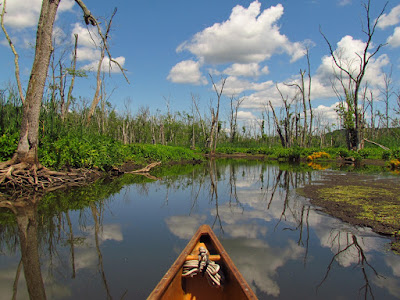The first osprey box is occupied by three chicks and one adult. Whether the chicks are flying yet or not is hard to say. If not, they will be soon, very soon. The second box is empty. Overhead are several osprey. The adults fly with purpose...either hunting or surveying the territory, and they fly with an elegance that indicates efficiency. The young can be picked out without trouble. Their wing motions are choppy...a flapping that comes too much from the outer wing. They are also engaged in play, trying out new maneuvers or playing a bit of tag with the others. I remember my first time at the controls of an airplane and imagine the grin pasted on their beaks. Box 3 has one chick in the nest that seems to be still working its wings and unsure of leaving the nest. Two siblings are fifteen yards off perched on dead tree limbs. Box 4 has an adult, but is otherwise empty. I don't remember if they had any chicks.
I spot a pair of yellow legs, which I haven't seen since late spring.
One bird that is barely present are the willets. I have seen only a couple by the time I reach the Sneak, a mile or so. The lack is enough to cause me to pause and get out on the spartina. Right away, three willets come my way calling out warning to the others. So, they are laying low and I imagine that this might be a critical nesting time, a time when they would prefer to remain undetected if possible.
The tide is falling, but only just starting and I have a tailwind and so I move up river at a good clip.
By the stone arch bridge a kingfisher flies past. Most of the time I flush them and they fly ahead in short hops out beyond the edges of the trees. This one does something more unusual and weaves through the trees and branches as it passes me heading down river.
I turn around at the Duck Hole Farms right where I spot two green herons. They are camera shy and leave the river's edge for more seclusion in the trees. I flush a black crowned night heron which flies over towards the old sawmill dam.
 |
| The Duck Hole Farms |
On my way down river I spot more willets. The tide has fallen a foot and a half and they are coming to feed on the mud banks. Still, it is not nearly as many as one sees earlier in the summer.





































